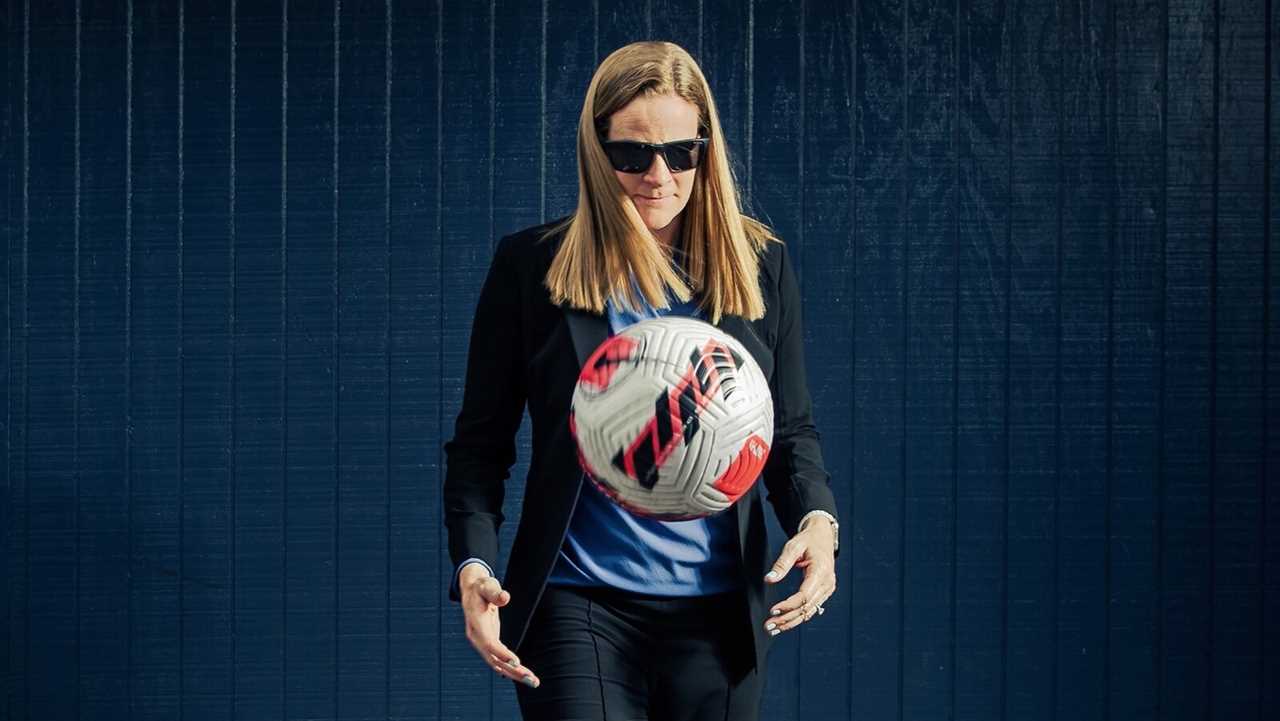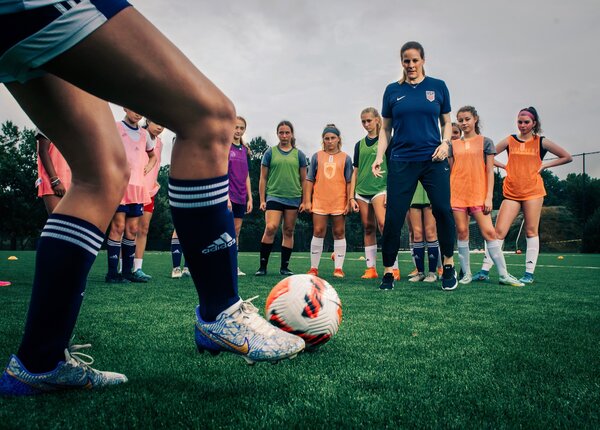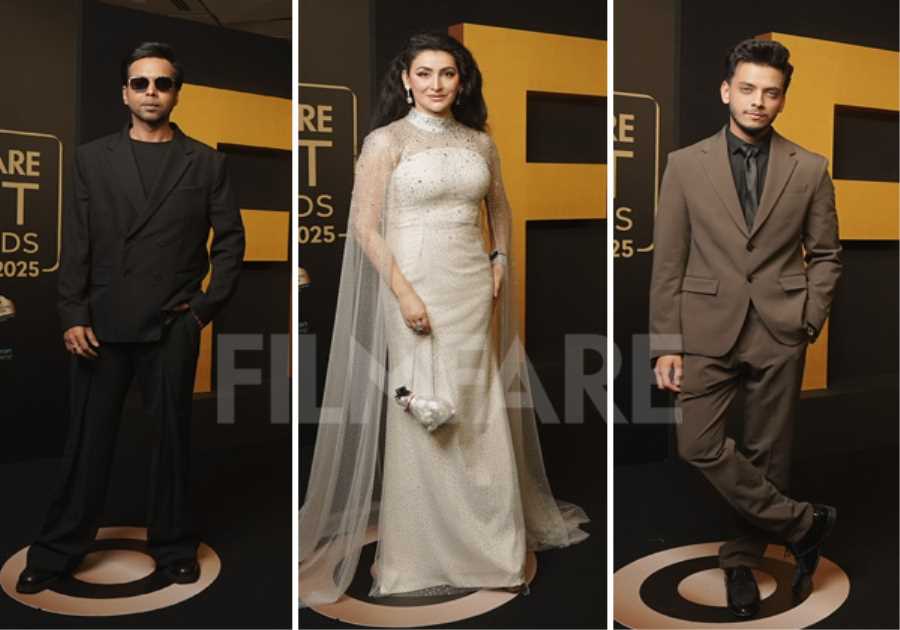
A meeting of the Fédération Internationale de Football Association, the governing body for world soccer, is an impressive professional gathering of “older men wearing ties,” as Gijs de Jong, who oversees the Royal Netherlands Football Association, describes it. The head of Mexico’s football federation is a former television executive who ran sports at Univision for a decade. Greece’s federation is led by the legal-and-political adviser to a former prime minister. The chairman of the Swedish Football Association, Fredrik Reinfeldt, actually is a former prime minister. The president of England’s Football Association is the Prince of Wales.
Listen to This Article
For more audio journalism and storytelling, download New York Times Audio, a new iOS app available for news subscribers.
Cindy Parlow Cone, the first female president in the 110-year history of the United States Soccer Federation, wears shorts to her day job. Cone, who coaches and supervises youth teams in North Carolina, is the first president who played the sport at an elite international level and, as far as anyone can tell, the first with no experience in business, politics or anything else outside soccer. Most meetings she convenes involve a bunch of teenage girls sitting in a semicircle. Unlike most federation heads, especially those in countries that take their ambitions in the sport seriously, Cone is paid no salary, a vestige of the early days of U.S. Soccer that the rank-and-file membership annually refuses to amend. (As of January, Cone will receive a $150,000 yearly stipend as a board member of Concacaf, which oversees soccer in North America.)
One afternoon this spring, Cone took time out from dealing with the fallout from a long-running scandal at U.S. Soccer — it involved the families of the U.S. men’s national team coach Gregg Berhalter and one of his players — to hold tryouts for 10- and 11-year-old girls at a field in Chapel Hill. Checking in players at a folding table, Cone greeted each by name. “Kaydyn, correct?” she said after one stepped up, waist-high to her mother. Kaydyn nodded gravely. Cone smiled. The mother smiled. After a bit more banter, Kaydyn smiled. “It’s a lot of pressure on the kids and their families,” Cone said. “We do what we can to make it fun.”
On the sideline shortly afterward, Cone moved like an athlete, her stride rangy and slightly pigeon-toed. “Check out the number of women coaches here,” she told me, counting off five of the seven who were working with the girls. “People tell me they don’t exist.” The next morning, she would fly to Chicago on federation business. For the moment, she was handing out practice jerseys.
Cone never had an ambition to become U.S. Soccer’s president. Her predecessor, Carlos Cordeiro, resigned under pressure in March 2020 while struggling to manage a dispute with the U.S. women’s national team. At the time, the organization was in shambles. Its chief executive, hired to run the daily business, had retired. The chief commercial officer had quit. U.S. Soccer was being sued in federal court by players on the U.S. women’s team. It was also being sued by the U.S. Soccer Foundation, an organization focused on expanding access to the sport that had partnered with the federation for a quarter-century. And within a week, the pandemic shut down the world.
Cordeiro, who had been a partner at Goldman Sachs, slotted in seamlessly among his international colleagues. Cone hardly seemed suited for the position. But the parlous state of U.S. Soccer was a condition that boardroom expertise couldn’t necessarily repair. “Her lack of business thoughts and ideals in that time of chaos might have been to her benefit,” says Mike Cullina, who runs a national organization that sanctions youth and adult clubs and also sits on the federation board. “She wasn’t thinking, ‘This is how we did it here.’” After inheriting the job from Cordeiro — she was in the largely ceremonial role of vice president — Cone says she “got freaked out for a little bit.” Then she created a de facto advisory board by contacting everyone she knew who might be able to help: former players, fathers of girls she had coached, friends who ran businesses outside soccer. “She recognized that U.S. Soccer was going through an almost existential crisis,” says one of those advisers, Don Garber, who is the Major League Soccer commissioner and also a board member.
‘If the women don’t win the World Cup, that will be a black eye for her, let’s be honest.’
In the months that followed, Cone compiled a daunting record of accomplishments. Most impressive, perhaps, was the settlement of the debilitating lawsuit filed against the federation by its women’s team, which resulted in equal compensation for male and female players. Along the way, she repaired some of the decades-long fractures between the organization’s numerous interest groups. She also helped arrange for the Club World Cup, a newly expanded tournament for 32 men’s professional teams, to debut in the United States in 2025. Last year, she was elected to her own four-year term. The idea of a former player running a major sport in America no longer seems so audacious. “Soccer looks a lot different today than it did when she took over,” says Kyle Martino, who played in M.L.S. and ran against Cordeiro and others in 2018. “And Cindy deserves the credit.”
Most Americans don’t see any of that. To them, U.S. Soccer means the men’s and women’s national teams. The women’s World Cup begins next week, and expectations are high. But the United States is trying to win a third World Cup in a row, something no national team, men’s or women’s, has done. And this is a far different squad from the one that romped through France four years ago; 14 of its 23 players are new. Jill Ellis, the architect of the last two championships, was succeeded as head coach by Vlatko Andonovski, a former men’s indoor player who lacked international coaching experience. While the United States has long been the dominant power in women’s soccer, everyone else seems to be catching up. In April in St. Louis, the team played Ireland, which has never even participated in a World Cup. The U.S. won, but the 1-0 score was perceived as a major accomplishment for Ireland — and a cautionary episode for the United States. “You start to see the gap beginning to narrow,” Diane Caldwell, an Irish defender, told me.

Though hiring coaches is part of what she does for a living, Cone stays a step removed from that responsibility for the national teams. She plays no role in choosing players or tactics. Yet her ultimate legacy may depend on the men’s and women’s results during her tenure. “If the women don’t win the World Cup, that will be a black eye for her, let’s be honest,” says John Motta, who runs the United States Adult Soccer Association and sits on the federation board. “Anything short of winning is not good for the United States” — and, by inference, not good for Cone.
U.S. Soccer has 250 employees and a $170 million budget. It fields and funds teams that compete internationally. It hires coaches, negotiates with sponsors and flies players and support staff where they need to go. But it also oversees youth soccer, recreational soccer and even wheelchair and beach soccer — a total of more than 3.7 million registered players. Cone presides over all of them. The comparison isn’t perfect, but imagine the commissioner of Major League Baseball also running Little League — and beer-league softball.
The divergent interests make for an unwieldy organization, and frequently a dysfunctional one. Votes are apportioned to membership blocs and state organizations. “The structure of U.S. Soccer requires that each member advocate for their own interests,” Garber says, and some of these members have been advocating on the local and regional levels for decades. To them, those teams on television in red, white and blue could constitute a distraction and a drain on resources. “I’ve experienced the tension between the grass roots” — meaning community soccer, at the youth and adult levels — “and the professionals,” Garber says. At times, that tension grinds the organization to a standstill. “I don’t think if someone was putting together the federation today, they would set it up like this,” Cone says.
Cone became involved because she felt that the professional players didn’t have sufficient representation. “Not only didn’t we have a voice in the room, we didn’t even know what decisions were being made,” she says. The women in particular have had a contentious relationship with U.S. Soccer pretty much since their sport emerged internationally, in the 1990s. In 2000, a U.S. team that included Cone boycotted a tournament in Australia. That was about being underpaid but also about equitable treatment. “It was ‘Why are we taking the Holiday Inn shuttle from the hotel to games?’” says Julie Foudy, a former member of the national team. “ ‘The men have four massage therapists. Why do we only have one?’”
Cone didn’t fit the profile of an activist. The late soccer writer Grant Wahl used to say that of all the players on the seminal 1999 team that won the World Cup, she was the last he would have envisioned as a federation president. “The quiet kid in the corner,” is how Foudy described her. Yet Cone, preternaturally competitive, is willing to push for what she wants. “All the time I was growing up, I knew I was different,” she says. “I would get asked all the time: ‘Why do you care so much? Why do you always have to win?’ It wasn’t just sports. I grew up in a time when it wasn’t cool to raise your hand in class. And girls were just kind of supposed to sit in the back. And I sat in the front. And I raised my hand.”
As a 16-year-old junior at Germantown High, outside Memphis, she called Anson Dorrance, the head coach at the University of North Carolina. She proposed finishing high school a year early and coming to play for him. About a year later, in 1996, women’s soccer would be included in the Olympics for the first time; to be considered for the U.S. team, Cone felt she first needed a season of elite competition. She targeted North Carolina, which had won the previous nine national championships. Dorrance gave her a scholarship.
She arrived at Chapel Hill ready to play. “Everything made sense to me on the field,” she says. Off it, though, she struggled. She rarely spoke to anyone. And she hadn’t learned to temper her competitive instincts. Dorrance would prod his players, often personalizing the criticism to make a point. It was a rite of passage among them, but he never criticized Cone. Teammates scorned her need to do every drill as if it were the waning moments of a championship final. She found her kindred spirits only when she made the Olympic team. “I was like, ‘Ah, there’s others!’” she says.
Cone won two N.C.A.A. championships at North Carolina. Playing forward for the United States, she won two Olympic gold medals and a World Cup. (Later, she coached the Portland Thorns in 2013, the first season of the National Women’s Soccer League. She won the title there too.) Outside soccer, she wasn’t particularly visible, but over nine years, until concussions ended her career in 2004, she was quietly as productive as any American, scoring 75 goals in 158 games. “She was stealth until that moment when she had to step up,” says Shannon Boxx, her U.S. teammate. “And then she wasn’t stealth. She was, ‘I’m coming to get you.’”
When the job of U.S. Soccer’s vice president opened up early in 2018, Cone, who had recently given birth, prodded Hamm and Foudy, among others, to seek the vacant position. It didn’t work. “I said, ‘Hell no, Cindy, I’m not doing that.’” Foudy says. “We were all still so angry with the federation. I was like: ‘I’m not sitting on that board. I want nothing to do with them.’” Several players agreed to run, then reconsidered. “The whole time, my husband kept saying to me, ‘You know you’re going to do it,’” Cone says. “And I’d say, ‘No way.’ And then I did.” In the end, Cone ran unopposed. By then, she understood that the federation’s vice president, like so many vice presidents, didn’t do much. But that was fine — she had set a precedent. “I had a foot in the door for the next person, who could move forward from there,” she says.
In March 2019, more than two dozen national team players filed a gender discrimination suit against U.S. Soccer. The issue of why the reigning world champions earned significantly less playing for their country than did the U.S. men, who hadn’t even made the 2018 World Cup, became a national debate. That July, when the women successfully defended their World Cup title at the final in Lyon, France, the usual chants of “U.S.A.! U.S.A.!” morphed into “Equal pay! Equal Pay!”
Cordeiro’s response was to fight the suit. In March 2020, a brief submitted by the federation argued that the men deserved higher salaries because their job “requires a higher level of skill based on speed and strength.” Cone says she thought the brief was “horribly offensive — I mean, who didn’t?” One of U.S. Soccer’s sponsors, Volkswagen, issued a statement calling it “simply unacceptable.” Though Cordeiro claimed not to have seen it before it was filed, his position became untenable, and he ended up resigning.
Cone had no plan ready for how to proceed, but she did have her competitiveness. She immersed herself in each issue like it was one of Dorrance’s drills. “She said: ‘I’m not failing. I’ll do whatever it takes,’” Cullina says. “That was her mind-set as a player, and that was her mind-set with this role.”
One April morning, Cone walked into a meeting at a hotel in Frisco, Texas. She was wearing her version of business attire: unconstructed blazer, black stretch pants and Nikes. From the head of a conference table, she opened the federation’s quarterly board meeting. It was 10 o’clock. She had been informed by the hotel that it was testing the fire alarm at 11. “So we have an hour,” she said. That was the only tension in the room.
As Cone moved through the agenda, the one discordant note came from Garber, who was attending virtually. He complained that the U.S. Open Cup, a knockout competition that included M.L.S. teams and clubs from lower tiers, was being played on substandard fields and that games were difficult to find on television. Otherwise, the session had the perfunctory air of a public utility’s shareholder meeting. Cone finished three minutes before the deadline.
The contrast with her first year as president was stark. “There were some rough times,” says Chris Ahrens, a Paralympian and a board member. Cone, who had never led an organization, struggled to keep discussions moving and defuse conflict. To many, she remained an accidental president serving as a place holder until the next election. But every week or two, it seemed, another issue was resolved. “She got some momentum,” Cullina says. “A win here, a win there.”
The lawsuit by the national-team players, who were seeking to be compensated for unequal treatment in the past, cast the longest shadow. Cone was a former member of the women’s players’ union, and she had committed to getting equal compensation for the women. But the deep animosity the players maintained for the federation made progress difficult. “There was zero trust,” says Becca Roux, the union’s executive director. There was resistance inside the federation too: The additional money to get the women’s compensation to the men’s level had to come from somewhere, and other constituent groups felt they were being asked to forsake too much. “I think the toughest thing she had to face was her own board,” says Mark Levinstein, who is the outside general counsel for the U.S. men. “She was managing two sides. We’d make a proposal and tell Cindy, and she’d have to go off and talk to her board and try to get approval.”
Early in 2022, the players agreed to settle the lawsuit for a lump sum — so long as the women and men would be paid the same going forward. But that still had to be approved by the board. Then, in March, the U.S. men qualified for last November’s World Cup. They had been playing for three years without a contract, and now they hinted that they might not play again until the fall without one, which would deprive U.S. Soccer of the revenue from preparatory exhibition matches. That put pressure on the board, which ultimately agreed to split prize money equally between the men and the women. Whatever the women make in the coming month will be added to the $13 million the men were awarded at last fall’s World Cup. Ten percent of that will go to U.S. Soccer; the athletes will divide the rest. “Because she was a former player and could see both sides, she was able to bridge gaps that never would have been bridged,” Roux says now.
Cone also faced resistance from some board members for the investigation she commissioned into allegations of sexual and emotional abuse by National Women’s Soccer League coaches. The N.W.S.L. was inexorably intertwined with U.S. Soccer, which created the league and ran it from inside its offices. After explosive stories in The Washington Post and The Athletic in the summer of 2021 revealed inappropriate behavior by the Portland coach Paul Riley and others, the federation hired Sally Q. Yates, a former acting U.S. attorney general, to investigate. (Riley told The Athletic by email that most of the allegations against him were “completely untrue.”) That was discomfiting enough for many federation members, considering the close ties between the organizations, but Cone then promised to circulate the results of the investigation and follow its recommendations. “She was committed to being transparent,” Yates says. “And I have to tell you, that is counterintuitive for the leader of any organization that finds itself in a crisis situation.”
‘Soccer looks a lot different today than it did when she took over.’
Inside U.S. Soccer, it was seen by some as evidence of Cone’s naïveté. “Somebody who thinks about it in terms of business would not commit to something without understanding the consequences and ramifications and legal exposure,” Cullina says. “You don’t immediately come out and say, ‘We’re going to be an open book.’ You say, ‘We’re going to study this.’” But Cone’s experience as a former athlete — and in a women’s sport — colored her perspective; she understood the vulnerability the N.W.S.L. players felt. And not only had Cone been a coach in the league; in that role, she had signed Mana Shim, who claims she was targeted by Riley, after a tryout camp. When Cone left the Portland Thorns after a single season, Riley succeeded her. “I’m not saying it’s rational, but I felt guilty that if I’d stayed, maybe none of it would have happened,” she says.
During Yates’s progress report at a board meeting last year, Cone was so disturbed by the details she was hearing that she found herself standing up. Pretending to want a cup of tea, she walked to the hot-water dispenser to compose herself. “It was very human,” Yates recalls. “She was setting the tone and the direction. To me, that made it really clear to the other board members that ‘We’re going to find out the truth.’” Last October, Yates submitted her report revealing widespread abuse. Cone made it public. Then she created an implementation task force and hired Shim to lead it.
At this year’s meeting in Frisco, Shim gave an update. Players were being surveyed about workplace issues. A protocol had been created for reporting new incidents. Permanent staff members had been hired. If anyone in the room still had qualms about how U.S. Soccer handled the situation, they weren’t sharing them. As she listened to the update, Cone couldn’t help smiling.
The week she was conducting tryouts, Cone set out on a morning walk from a coffee shop near her home in neighboring Carrboro to the North Carolina campus. Along the way, I asked her about Berhalter, the coach of the men’s national team. She pointed across Franklin Street, Chapel Hill’s main drag. “Right over there is where it happened,” she said, referring to a decades-old incident that had recently ignited a scandal. As a college freshman in 1992, Berhalter fought with Rosalind Santana, his future wife, outside a bar. He shoved Santana to the ground and kicked her.
Santana’s roommate at the time, Danielle Egan, later married Claudio Reyna, a leading American player. Subsequently, Berhalter and Reyna were World Cup teammates in 2002 and 2006; at both tournaments, Reyna was the U.S. captain. In 2021, while working as an executive for the M.L.S. club Austin F.C., Reyna acquired the Berhalters’ son, Sebastian, for that season. When it ended, Reyna declined to keep him on the team. The Reynas also have a soccer-playing son, Gio, who was expected to be a major contributor for the United States at the World Cup but played only 52 minutes. Berhalter’s sporadic use of Reyna, which generated critical commentary, looked suspiciously personal.
Following the World Cup, Danielle Reyna told U.S. Soccer about Berhalter’s college fight with Santana. Any discussions about extending Berhalter’s expired contract had to be put off so that an investigation could be done. It was hard not to see the entire sordid episode as a microcosm of the federation: common interests undermined by feuds and rivalries — “some of which,” Cone says, “have existed before I was born.”
Berhalter, who was candid and remorseful about the decades-old incident, was cleared in March. That meant only that he could again be a candidate for the position. In June, following an extensive search — characterized as data-driven by the federation — and a six-month stretch without a permanent coach, Berhalter was rehired. That struck many observers as preposterous, or worse — “a sham and an embarrassment,” as Craig Burley of ESPN put it.
Nevertheless, many American fans are optimistic about how the U.S. men will fare at the 2026 World Cup, much of which will be held in the United States. The U.S. team hasn’t reached the quarterfinal round since 2002, yet it isn’t unusual to hear commentators say that nothing short of a semifinal will qualify as a success. It should be noted that the tenure of U.S. Soccer’s president before Cordeiro ended because of a disappointing result by the U.S. men. After a loss to tiny Trinidad and Tobago caused the team to miss the 2018 World Cup, Sunil Gulati, an economist who had guided the federation for more than a decade, announced that he would not seek re-election. Cone didn’t directly hire Berhalter, but her fortunes now are at least partly intertwined with his.
This April, the men played an exhibition match against Mexico in Glendale, Ariz. Before the game, Cone, who had flown in to support them, met with current and prospective sponsors at a restaurant near the stadium. Later, she did a breezy interview on Telemundo, breaking news that she had saved for the occasion: The United States and Mexico had submitted a joint bid to host the women’s World Cup in 2027. At halftime, she led a group of federation executives down the concourse to Mexico’s suite for an exchange of gifts, which is common at international games.
Cordeiro and the men who preceded him as president spent their professional lives engaged in rituals like these. Cone has spent hers on soccer fields, coaching teenagers. While leading the organization these past three years, her diplomatic skills have grown immeasurably. Temperamentally, though, she’s still that quiet kid in the corner. Posing while presenting a framed photo of the U.S. team to Mexico’s delegation, she looked as uncomfortable as I’d seen her.
Moments later, she was handed a small box. Inside was a wooden alebrije, a piece of Mexican folk art, that had orange horns and a textured magenta body. An evocative work, it made the framed photo seem perfunctory by comparison. Cone cooed appropriately, but then her eyes narrowed. “We’re going to have to up our gift game,” she said.
Bruce Schoenfeld is a frequent contributor to the magazine and the author of “Game of Edges: The Analytics Revolution and the Future of Professional Sports.” Dina Litovsky is a Ukrainian-born photographer living in New York. Her work explores the idea of leisure, often focusing on subcultures and social gatherings. In 2020, she won the Nannen Prize (now called the STERN Prize) for documentary photography.
-----------------------
By: Bruce Schoenfeld
Title: She’s Got the Hardest Job in Soccer. Can She Keep Winning?
Sourced From: www.nytimes.com/2023/07/13/magazine/us-soccer-cindy-parlow-cone.html
Published Date: Thu, 13 Jul 2023 09:00:44 +0000






